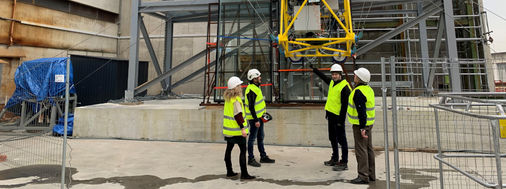- The project has as its aim to increase automation in the façade installation and maintenance processes, as well as incorporating robotics into the construction sector, thereby enhancing final quality, streamlining the installation process and minimising risks
- The innovative new system, named Hephaestus after the Greek god of metalworking, is expected to be on the market within five years
Bilbao, 7 February 2020. A robot named after a Greek god is the newest solution towards safer façade installation processes. The cable-driven robot has been developed as part of the European Hephaestus project, named after the Greek god of metalworking. It moves along building façades, performing assembly-related tasks, such as installing anchoring systems and positioning and installing other components, as well as performing maintenance and cleaning tasks. The pioneering initiative is the brainchild of a consortium of nine European companies and universities, coordinated by the TECNALIA Research and Technological Development Centre, and is expected to be on the market within five years.
The initiative focuses on providing novel solutions to one of the most important segments of the construction industry, dealing with the installation and maintenance of façades. It has been designed to increase automation in the façade installation and maintenance processes, as well as incorporating robotics into the construction sector, thereby enhancing final quality, streamlining the installation process and minimising risks. This is expected to strengthen the European construction sector and position the robotics industry within this field as an important factor in new digitalisation and automation processes.
At present, the lack of automation in façade installation and maintenance procedures gives rise to quality-related issues, such as damp and air leakage; it is also riskier and costlier. The benefits of the automation processes developed by the Hephaestus project include a 20% reduction in installation times and costs; reductions of up to 44% in annual maintenance and cleaning costs; and increased façade quality and worker safety. In fact, rolling out Hephaestus will require specialised workers who will be able to work under maximum safety conditions, one of the main challenges currently facing the sector.
Pioneering Technology
Hephaestus is based on using cable-driven robots that move along the façade, coupled with two systems: one which puts the required anchoring system in place (drilling the façade, positioning anchors and attaching them to the structure); and another to pick up glass curtain walls and put them in their final position on the façade. Every detail of the process is meticulously controlled and connected to the BIM system - software which allows buildings to be designed in 3D and which gathers information for a range of purposes, such as predicting how the building will respond to energy levels, acoustics, etc.
After installation, the system may be adapted for façade maintenance and cleaning tasks, taking over from the suspended platform type units currently in use.
Hephaestus is a part of the European Horizon 2020 Programme, funded by the European Commission and ending in 2020. It is the brainchild of a consortium of European companies, universities and technology centres: TECNALIA (Coordinator), CEMVISA VICINAY and ACCIONA Construcción (Spain); LMU Munich University and Fraunhofer- IPA (Germany); CNRS LIRMM (France); NLINK AS (Norway); FOCCHI SPA (Italy); and R2M SOLUTION LTD (UK).
The robot's capabilities will be showcased in two pilot demonstrations. For the first, TECNALIA will simulate a steel building; and for the second, Acciona Construcción will simulate a concrete building at its Toledo plant.

